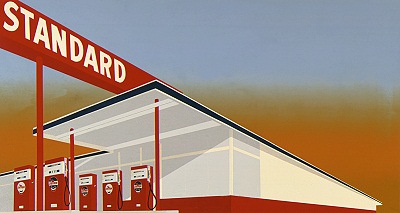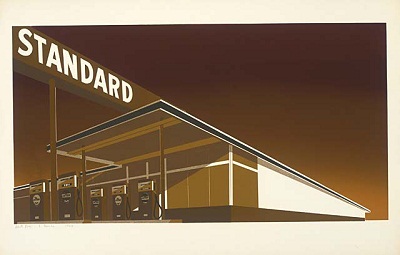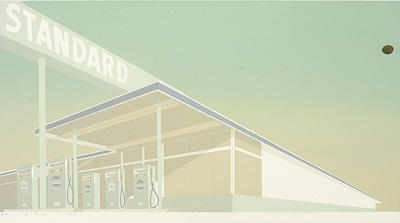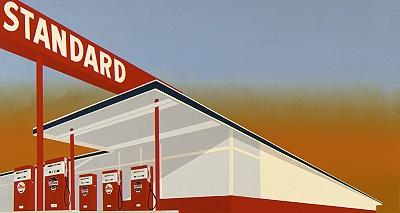“It has to be called an icon; that’s the main thing about that painting…It became a motif for me to explore in other ways, too. I saw it as a loaf of bread; I saw it as several other things.”—Ed Ruscha on the painting Standard Station, Amarillo, Texas (1963) in 1981.
In the early twentieth century, John D. Rockefeller’s Standard Oil was the largest company in the world, selling more than half the petroleum products in the United States. In 1911 the federal government broke it up into seven “Baby Standards,” one of largest of which was Standard Oil of Southern California. The reach of this Baby Standard stretched from the Pacific Ocean to Texas, and it retained the Standard brand name until 1984, when it officially became Chevron. In the late 1950s and early 1960s, when Ed Ruscha frequently drove Route 66 from Los Angeles to his family home in Oklahoma City, Standard Stations were commonplace. This ubiquity led to the inclusion of a Standard gas station in Ruscha’s groundbreaking photographic book Twentysix Gasoline Stations in 1963. He subsequently depicted the edifice in several paintings (alone, with a dime store magazine, and engulfed in flames) and five prints spanning from 1966 to 2011. LACMA is fortunate enough to be able to show these prints in the exhibition Ed Ruscha: Standard, which opens in the Broad Contemporary Art Museum to members today and to the public on Saturday.

Ed Ruscha, Standard Station, 1966, Museum Acquisition Fund, © 2012 Ed Ruscha. All rights reserved, photo © 2012 Museum Associates/LACMA
The allure of the Standard Station for Ruscha is both its subject and its form. The world of trademarks that can be seen from the car is one of his signature artistic subjects. When Ruscha was included in the seminal 1962 Pop Art exhibition The New Painting of Common Objects at the Pasadena Art Museum, he had already declared his interest in elevating the mundane and the overlooked, an approach he maintains today. Although the source photograph from Twentysix Gasoline Stations is documentary in style, Ruscha’s prints of the station transform it into something more than a place to fill your car’s tank. In Standard Station (1966) the cantilevered roof, surmounted by the brand name, projects decisively from the lower right to the upper left of the sheet, slicing diagonally across the lurid, smoggy sunset in the background.

Ed Ruscha, Mocha Standard, 1969, gift of The Jane & Marc Nathanson Family Foundation, © 2012 Ed Ruscha. All rights reserved, photo © 2012 Museum Associates/LACMA
This thrust is similarly present in three of the other Standard prints, and is crossed by a second sign going the other direction in the print Double Standard. Although the composition of the first Standard Station is consistent throughout the prints, Ruscha altered the iterations. Mocha Standard (1969) exchanges the bright primary colors of first one for tones of brown as though the sunset has been overtaken by a toxic, smoky twilight. In Cheese Mold Standard with Olive (also 1969), foodstuffs provide a greenish chromatic note.

Ed Ruscha, Cheese Mold Standard with Olive, 1969, gift of The Jane & Marc Nathanson Family Foundation, © 2012 Ed Ruscha. All rights reserved, photo © 2012 Museum Associates/LACMA
Ruscha’s most recent iteration of the Standard Station motif, Ghost Station (2011), omits color entirely, leaving the subtle shadows of the embossed paper to demarcate the now-familiar image. Like all good icons, the Standard Station is both constant and mutable and has remained a touchstone for Ruscha for nearly fifty years.
Sienna Brown, Wallis Annenberg Curatorial Fellow, Prints and Drawings Department



